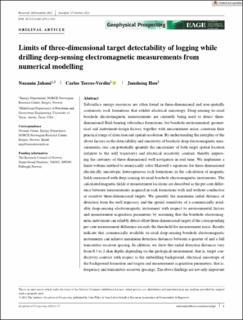| dc.contributor.author | Jahani, Nazanin | |
| dc.contributor.author | Torres-Verdin, Carlos | |
| dc.contributor.author | Hou, Junsheng | |
| dc.date.accessioned | 2023-11-24T11:20:32Z | |
| dc.date.available | 2023-11-24T11:20:32Z | |
| dc.date.created | 2023-11-02T12:58:11Z | |
| dc.date.issued | 2023 | |
| dc.identifier.citation | Geophysical Prospecting. 2023, . | en_US |
| dc.identifier.issn | 0016-8025 | |
| dc.identifier.uri | https://hdl.handle.net/11250/3104517 | |
| dc.description.abstract | Subsurface energy resources are often found in three-dimensional and non-spatially continuous rock formations that exhibit electrical anisotropy. Deep-sensing tri-axial borehole electromagnetic measurements are currently being used to detect three-dimensional fluid-bearing subsurface formations, but borehole environmental, geometrical and instrument-design factors, together with measurement noise, constrain their practical range of detection and spatial resolution. By understanding the interplay of the above factors on the detectability and sensitivity of borehole deep electromagnetic measurements, one can potentially quantify the uncertainty of both target spatial location (relative to the well trajectory) and electrical resistivity contrast, thereby improving the certainty of three-dimensional well navigation in real time. We implement a finite-volume method to numerically solve Maxwell's equations for three-dimensional electrically anisotropic heterogeneous rock formations in the calculation of magnetic fields measured with deep-sensing tri-axial borehole electromagnetic instruments. The calculated magnetic fields at measurement locations are described as the per cent difference between measurements acquired in rock formations with and without conductive or resistive three-dimensional targets. We quantify the maximum radial distance of detection from the well trajectory and the spatial sensitivity of a commercially available deep-sensing electromagnetic instrument with respect to environmental factors and measurement acquisition parameters by assuming that the borehole electromagnetic instrument can reliably detect offset three-dimensional targets if the corresponding per cent measurement difference exceeds the threshold for measurement noise. Results indicate that commercially available tri-axial deep-sensing borehole electromagnetic instruments can achieve maximum detection distances between a quarter of and a full transmitter–receiver spacing. In addition, we show that radial detection distances vary from 0.3 to 2 skin depths depending on the geological environment, that is, target conductivity contrast with respect to the embedding background, electrical anisotropy of the background formation and targets and measurement acquisition parameters, that is, frequency and transmitter–receiver spacings. The above findings are not only important for instrument design and measurement-acquisition planning but also for the effective implementation of real-time inversion-based measurement interpretation procedures. | en_US |
| dc.language.iso | eng | en_US |
| dc.rights | Navngivelse 4.0 Internasjonal | * |
| dc.rights.uri | http://creativecommons.org/licenses/by/4.0/deed.no | * |
| dc.title | Limits of 3D target detectability of logging while drilling deep-sensing electromagnetic measurements from numerical modeling | en_US |
| dc.title.alternative | Limits of 3D target detectability of logging while drilling deep-sensing electromagnetic measurements from numerical modeling | en_US |
| dc.type | Peer reviewed | en_US |
| dc.type | Journal article | en_US |
| dc.rights.holder | © 2023 The Authors | en_US |
| dc.description.version | publishedVersion | en_US |
| cristin.ispublished | true | |
| cristin.fulltext | original | |
| cristin.qualitycode | 1 | |
| dc.identifier.doi | 10.1111/1365-2478.13451 | |
| dc.identifier.cristin | 2191449 | |
| dc.source.journal | Geophysical Prospecting | en_US |
| dc.source.pagenumber | 17 | en_US |
| dc.relation.project | Norges forskningsråd: 336385 | en_US |
| dc.relation.project | Norges forskningsråd: 309589 | en_US |

